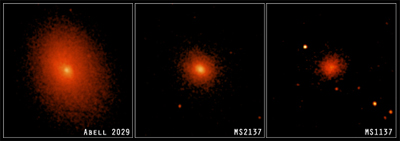New observations from the space telescope confirm once and for all that the universe is largely composed of dark energy.

A team of astrophysicists used NASA's Chandra Space Telescope to measure X-rays from 26 galaxy clusters. The observations suggest that the expansion of the universe is accelerating. For this to occur, some repulsive gravitational force must overshadow normal gravity, a force known as dark energy by cosmologists.
The acceleration in the expansion of the universe was first discovered in the 1990s by observing distant supernova explosions. After that she received further confirmation in the form of deciphering the detailed patterns of the spots in the cosmic background radiation, the "glow of the big bang".
However, both of these methods rely on uncertain physics. "A supernova is a very complex thing," says Steve Allen from the University of Cambridge in the UK, head of the research team. He says their approach is "simple - it's just the physics of hot gases."
Simplicity is a relative concept of course. Galaxy clusters are huge accumulations of hundreds of galaxies, containing considerable amounts of gas at temperatures of about one hundred million degrees Celsius, a temperature hot enough to emit X-rays.
Measuring the frequency and brightness of the X-rays and knowing the distance to the cluster make it possible to calculate the proportion of gas from the total mass of the cluster.
If you want to measure the distance, simply do the calculation in reverse. It is estimated that the proportion of gas is more or less the same in all clusters, so making this single assumption allowed the team to calculate the distance to each cluster. Then, by placing the distances on a cosmic time scale, they found that the expansion of the universe began to accelerate about 6 billion years ago.
Their result is in agreement with the measurements from the supernovae and the cosmic background radiation. All three methods imply that 75% of the energy content of the universe is in the form of repulsive energy. "It gives us much more confidence that dark energy is real," Allen says.
But what is that dark energy? According to the new measurements, this is energy, which does not actually change over time. It may be energy, originating in empty space itself, like Einstein's cosmological constant.
However, the constraints on dark energy are not pressing, which leaves room for many possibilities. These possibilities include a kind of weakened field of dark energy, called the "free element" (quintessence). Another possibility mentions some kind of ever-increasing energy, which may eventually become so powerful that it literally tears apart everything in the universe, even atoms.
Maybe it's something more exotic. Allen's team is currently applying to use Chandra to observe additional galaxy clusters. They hope this way to narrow down the range of options.
Translation: Dikla Oren
Dark energy could tear the universe apart
Haaretz, News and Walla
Are the galaxies moving away from each other at an increasing rate? If the answer is yes, then the universe is in for a particularly turbulent end
Observations of giant clouds in distant galaxies reveal new evidence for the force that caused the universe to expand, NASA astronomers said yesterday.
The results of the observation are a confirmation of one of the strangest discoveries of modern astronomy - the expansion of the universe is accelerating. According to the discoveries, the galaxies are moving away from each other at an increasing speed, due to a counter-gravitational force known as "dark energy". The conclusions of the observation open a window, according to the astronomers, to investigate the nature of that "dark energy" and to understand its influence.
Astronomers used an X-ray detector satellite to observe hot gases in galaxies far from Earth. By analyzing the X-rays emitted by those gases, the astronomers measured the distance of the Earth from those galaxies and the speed of their receding. This observation made it possible to trace the way the universe expanded during the last 10 billion years.
Until now, most studies of the universe's expansion rate, including those that led to the discovery of dark energy, used exploding stars, known as type 1 supernovae, as markers for measuring cosmic distances.
Parallel universes
Dark energy has amazed researchers since two groups of astronomers discovered six years ago that the speed of expansion of the universe is not decreasing, as they assumed until now, but is accelerating. Dr. Andrew Fabian, from the University of Cambridge, compared the phenomenon to watching an apple thrown in the air and rising up with increasing speed instead of falling back down.
An explanation given for the phenomenon, and rejected by Albert Einstein, is that space itself has a force opposite to gravity. However, according to modern physics this force is 10 times greater to the 60th power than the measurements of the astronomers. This discovery led the astronomers to look for other explanations for the accelerated judgment. Among the explanations considered: the existence of parallel universes or particles and undiscovered forces.
One of the questions that bothers researchers in the field is whether the amount of dark energy changes. If the amount of energy is constant, then Einstein's hypothesis was correct and the galaxies will move away from each other at a speed too high to be seen in the next 100 billion years.
If they find that the amount of energy is increasing, this could mean that one day the universe will tear itself apart and come to an end - an effect during which even single atoms will not remain intact. The new observation results correspond to Einstein's hypotheses but also do not contradict the possibility that the intensity of dark energy changes
